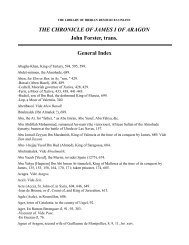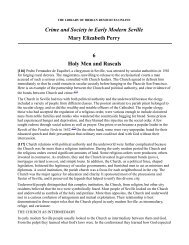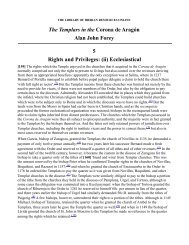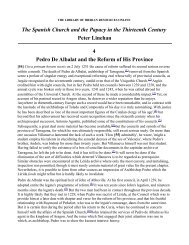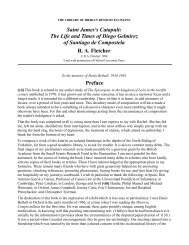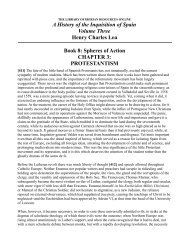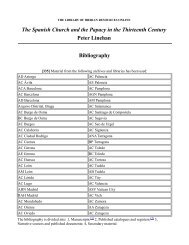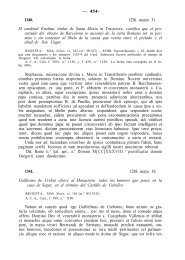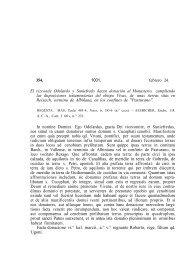Chapter 12 - The Library of Iberian Resources Online
Chapter 12 - The Library of Iberian Resources Online
Chapter 12 - The Library of Iberian Resources Online
Create successful ePaper yourself
Turn your PDF publications into a flip-book with our unique Google optimized e-Paper software.
system, the size <strong>of</strong> the canal and its place in the hierarchical network from main canal down to field,<br />
and the function <strong>of</strong> the system, whether for delivery or drainage. (7)<br />
A similar pattern is evident in the words used to describe hydraulic wheels. Strictly speaking, a noria is<br />
a wheel moved by the force <strong>of</strong> the current alone, while a sinia is one moved by human or animal<br />
power: but only in Murcian usage is this distinction correctly made. In Catalonia and Valencia sinia<br />
displaced noria completely and was used to describe all hydraulic [219] wheels. In other parts <strong>of</strong> Spain<br />
the common word for diversion dam, azud (and its variant azuda), came to be applied to the current<br />
wheel. (8)<br />
At the base <strong>of</strong> this fluidity is regional variation in irrigation customs along ethnic lines. Terminology<br />
varied principally as the ethnic composition <strong>of</strong> the original Muslim irrigators and the Christian settlers<br />
varied. <strong>The</strong> place <strong>of</strong> arabisms in the picture is crucial. <strong>The</strong> fact that there were not enough terms in the<br />
Romance tongues <strong>of</strong> the conquerors to replace the multiplicity <strong>of</strong> definitions in a highly developed<br />
irrigation system made this sector <strong>of</strong> the lexicon particularly susceptible to linguistic borrowing; the<br />
fact that Arabic was unintelligible to most <strong>of</strong> the new settlers ensured that the borrowing would be<br />
loosely structured. Thus many areas <strong>of</strong> human thought and industry were described by two sets <strong>of</strong><br />
terms. <strong>The</strong> Romance tongue <strong>of</strong> the Christians, together with Latin expressions <strong>of</strong> long acceptance in<br />
Catalonia and Castile, coexisted with words acquired from the Arabs. Irrigation was one <strong>of</strong> those areas<br />
<strong>of</strong> culture (warfare was another) where the arabisms tended to predominate.<br />
That many <strong>of</strong> the concepts <strong>of</strong> irrigation were new to the Christians is indicated by the intrusion <strong>of</strong><br />
vernacular arabisms into Latin documents in the thirteenth and early fourteenth centuries. This<br />
phenomenon is indicative <strong>of</strong> the lack <strong>of</strong> consensus concerning a given term (evidence <strong>of</strong> entrenched<br />
regional variation, in other words), and the lack <strong>of</strong> a Latin or Romance tradition to guide the scribe. (9)<br />
REGIONAL AND LOCAL VARIATION<br />
Most <strong>of</strong> the arabisms common throughout eastern Spain were present either in Castilian or Catalan by<br />
the thirteenth century. Sinia and safareig, both specialized hydraulic devices, were among the earliest<br />
peninsular arabisms, dating from the epoch <strong>of</strong> Islamic expansion (711 to the mid-eleventh century).<br />
Cequia and açut, the most common and typical <strong>of</strong> Valencian irrigation arabisms, date from the epoch <strong>of</strong><br />
the great Christian conquests (mid-[220]eleventh to the end <strong>of</strong> the twelfth century) and were therefore<br />
already in the language when the Valencian region was taken from the Muslims. Alcaduf, aljub,<br />
azumbre, çabacequies, and marjal are arabisms which passed into the Romance vernaculars in the<br />
course <strong>of</strong> the thirteenth century. (10) Most <strong>of</strong> the localized arabisms as well must have passed into the<br />
Christian vernacular in the late thirteenth century during the post-Conquest process <strong>of</strong> learning local<br />
customs from Muslim irrigators.<br />
<strong>The</strong> lists that follow include all the important regional arabisms and most <strong>of</strong> the significant local ones;<br />
the contents <strong>of</strong> the lists are summarized in Tables 22 and 23.<br />
Regional Irrigation Arabisms<br />
1) açut (çut, azut), "diversion dam," Arabic al-sudd; the most common and widest spread arabism<br />
besides cequia. <strong>The</strong> Romance equivalent, resclosa, retains the sense <strong>of</strong> the original Arabic sadda, to<br />
close. <strong>The</strong> word has been used consistently throughout eastern Spain from the Reconquest to the<br />
present, and the Castilian form, azud, dates from the period <strong>of</strong> the great Christian conquests (1050 to<br />
the end <strong>of</strong> the twelfth century). Both the word sudd and the technology are typical <strong>of</strong> southern Arabia.<br />
(11)




